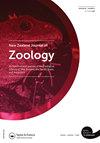环境DNA的动物学应用:检测、多样性和健康
IF 1.1
4区 生物学
Q3 ZOOLOGY
引用次数: 0
摘要
在过去的十年中,环境DNA (eDNA)监测已经彻底改变了生物多样性的调查方式。现在有无数的eDNA协议和技术开发,以提高eDNA从环境样本中分离,大大多样化了eDNA在物种监测类型中的应用,现在可以进行。随着这些应用范围的扩大和更多的研究表明这些工具有希望为环境管理提供信息,最终用途机构更有可能将其作为日常监测的一部分加以采用。事实上,问题不再是这些eDNA方法是否有效,而是能否实现可重复性,从而为管理决策提供信息。现在越来越多的趋势是单独或与传统技术结合使用这项技术来评估生物多样性和探测单一物种,如受威胁物种或入侵物种。然而,由于eDNA是一种间接的检测形式,因此与eDNA监测相关的不确定性仍然存在,管理人员仍在努力解决如何使用eDNA结果来进行自信的决策和管理的问题。为了使eDNA成为诸如国家环境状况(SoE)报告等立法要求的常规工具,有必要弥合研究和管理之间的差距。特别是,需要严格和高度审查的工作流程来提供一致和可重复的分子结果,从而可靠地告知管理层。在新西兰,一些研究强调了将eDNA应用于各种不同环境以实现一系列目的的潜力。新西兰也面临着与全球相同的环境压力,例如物种入侵、栖息地破碎、气候变化、水质下降等等。各机构采用这些eDNA工具有很大的好处,因为如果应用得当,它们可以更具成本效益,广泛分发,并使收到的数据更加一致。这一特殊问题是向前迈出的重要一步,提供了必要的数据,可以为适用于特定目的的适当方法提供信息,并了解在广泛采用这些工具之前仍需要解决的一些限制和差距。希望设计自己的eDNA研究的读者最好参考一些讨论eDNA研究方面的综述论文,如:实验设计,例如(Goldberg et al. 2016),记录元数据,例如(Nicholson et al. 2020);DNA提取方法的选择,例如(Lear et al. 2018;Jeunen et al. 2019);选择适合研究问题的基因组区域,例如(Drummond et al. 2015;Jeunen et al. 2019);qPCR研究的报告要求,例如(Bustin et al. 2009);eDNA研究中使用的不同技术的利弊(Zaiko et al. 2018);eDNA研究的局限性(Kelly et al. 2019);并且可以将eDNA监测所需的工具嵌入管理计划(Sepulveda et al. 2020)。利用直接来自环境的DNA作为通过宏基因组学了解微生物多样性的手段是一项历史最悠久的技术。本文章由计算机程序翻译,如有差异,请以英文原文为准。
Zoological applications for environmental DNA: detection, diversity, and health
Environmental DNA (eDNA) monitoring has revolutionised the way biodiversity is surveyed over the past decade. There is now a myriad of eDNA protocols and techniques developed to improve eDNA isolation from environmental samples, greatly diversifying eDNA applications in the types of species surveillance that can now be undertaken. As the breadth of those applications increase and more studies show the promise of these tools to inform environmental management, there is greater impetus in the uptake by end-use agencies as part of routine monitoring. Indeed, the question is no longer if these eDNA methods work, but rather if reproducibility can be achieved to inform management decisions. There is now an increasing tendency to use the technology, either alone or in tandem with conventional techniques, in biodiversity assessments and in detection of single species such as threatened or invasive species. However, due to eDNA being an indirect form of detection, there are still uncertainties associated with eDNA monitoring and managers still struggle with how to use eDNA results in confident decision-making and management. In order for eDNA to become a routine tool for legislative requirements such as national State of the Environment (SoE) Reporting, there is a need to bridge the gap between research and management. In particular, stringent and highly scrutinised workflows are needed to deliver consistent and repeatable molecular results that can reliably inform management. In New Zealand, a number of studies have highlighted the potential for eDNA to be applied to a variety of different environments for a range of purposes. New Zealand also faces the same environmental pressures seen globally such as invasive species, habitat fragmentation, climate change, declining water quality as just a few examples. There is a great benefit for agencies to be adopting these eDNA tools as they can be more cost-effective, be widely distributed and enable greater consistency in the data received if applied appropriately. This special issue is a significant step forward in providing the necessary data that can inform the appropriate methods to apply for a particular purpose and to also understand some of the limitations and gaps that still need to be addressed before these tools are widely adopted. Readers looking to design their own eDNA studies would be well advised to consult some review papers discussing such aspects of eDNA studies as: experimental design e.g., (Goldberg et al. 2016), recording metadata e.g., (Nicholson et al. 2020); choice of DNA extraction method e.g. (Lear et al. 2018; Jeunen et al. 2019); selection of genome regions appropriate for the research question being asked e.g., (Drummond et al. 2015; Jeunen et al. 2019); reporting requirements for qPCR studies e.g. (Bustin et al. 2009); the pros and cons of the different techniques used in eDNA studies (Zaiko et al. 2018); limitations of eDNA studies (Kelly et al. 2019); and the tools needed before eDNA monitoring can be embedded within management programmes (Sepulveda et al. 2020). The use of DNA sourced directly from the environment as a means of understanding microbial diversity via metagenomics has been a technology with the longest history.
求助全文
通过发布文献求助,成功后即可免费获取论文全文。
去求助
来源期刊
CiteScore
2.80
自引率
0.00%
发文量
20
审稿时长
>12 weeks
期刊介绍:
Aims: The diversity of the fauna of the southern continents and oceans is of worldwide interest to researchers in universities, museums, and other centres. The New Zealand Journal of Zoology plays an important role in disseminating information on field-based, experimental, and theoretical research on the zoology of the region.

 求助内容:
求助内容: 应助结果提醒方式:
应助结果提醒方式:


